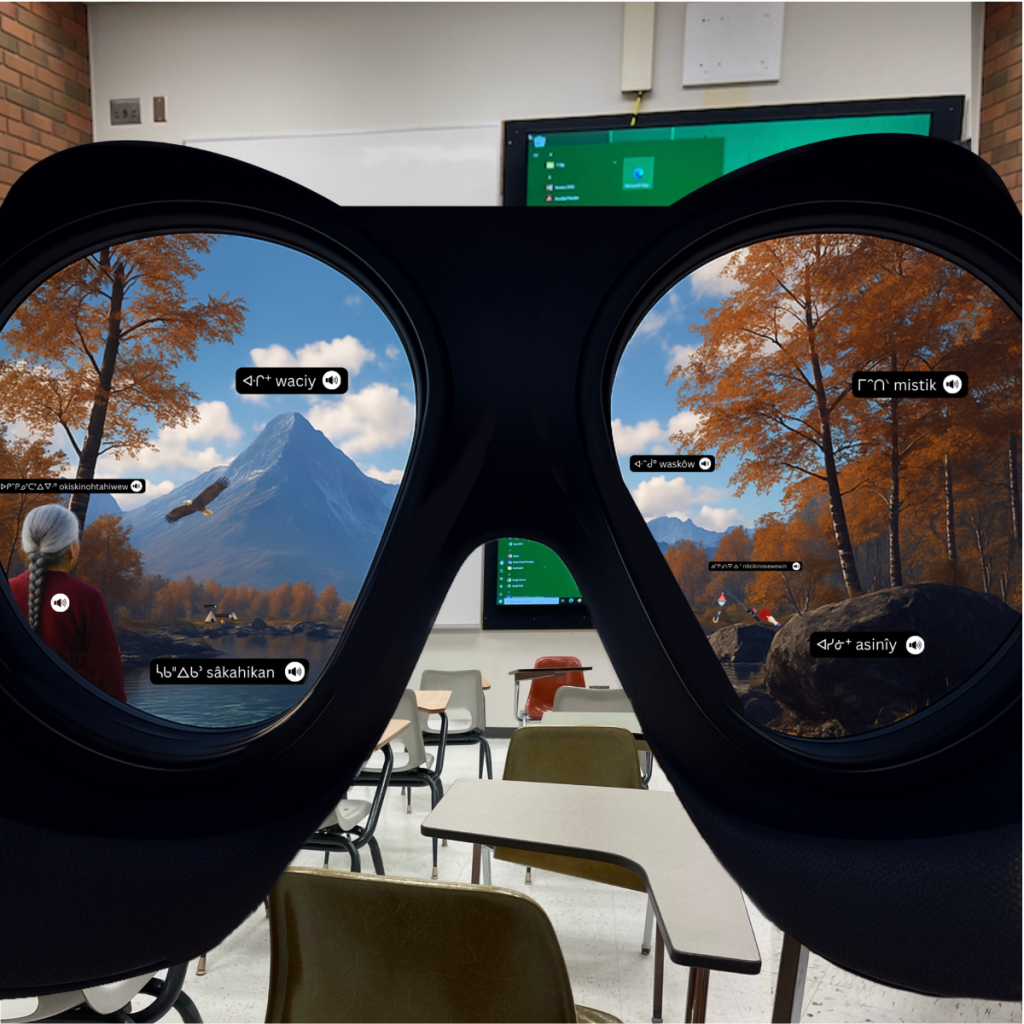Submission 2025
| Submitted by: | Allyson Lynch |
| Department: | Anthropology |
| Faculty: | Arts |
Framed through a VR headset, this image captures the immersive experience of learning Indigenous languages through digital landscapes. From within a real-world classroom, students are transported into a virtual environment where mountains, trees, lakes, and animals are labeled with Indigenous words. An Elder stands at the edge of the lake, grounding the scene in cultural continuity and knowledge transmission. This image represents my Master’s research on virtual reality as a tool for Indigenous language revitalization. It reflects the potential for immersive technologies to reconnect youth with land-informed language learning, foster deeper engagement, and support intergenerational knowledge transfer. The juxtaposition of classroom and cultural landscape illustrates how digital tools can respectfully integrate traditional ways of knowing into future-forward learning environments, making language learning more embodied, relational, and available to those displaced from traditional lands.
Was your image created using Generative AI?
Yes.
Did you upload any materials into an AI tool to help generate your image?
Yes.
Which model of generative AI did you use?
DALL-E 2 by OpenAI.
How was your image created?
This image was created using Canva, blending classroom and headset-view layers to visualize immersive language learning. Individual elements were generated using ChatGPT with DALL·E image tools, including the headset lens frame, and Elder with braided hair. Cree language translations were sourced from creedictionary.com, using accurate Y dialect terms and syllabics. Audio icons were added to represent oral learning and pronunciation features within a VR environment. The composition reflects my research approach—centering culturally grounded methods, digital storytelling, and user engagement—showing how virtual platforms can support immersive and respectful Indigenous language learning.
How did you craft your prompt to guide the generative AI in creating your image? Please describe the technique or approach you used to convey your vision to the AI.
My goal was to visually represent the core themes of my thesis: immersive Indigenous language learning, classroom-to-landscape transformation, and intergenerational knowledge transfer. I crafted prompts using specific keywords like “first-person VR headset view,” “digital autumn landscape,” and “Indigenous Elder with braided grey hair.” I gave clear stylistic instructions such as “realistic but digital,” “serene and immersive,” and “natural lighting.” I iterated and refined multiple prompts to ensure the balance between realism and conceptual symbolism. When needed, I focused on individual visual elements—like the Elder, or the headset view—and layered them in Canva. I guided the AI with storytelling logic, ensuring the final image reflected my research’s emotional, educational, and cultural dimensions. No advanced controls were used, but precision in wording and feedback refinement were key.
Please describe what you uploaded to the AI tool, and confirm that the material is your original work, licensed for use (e.g., Creative Commons), used with proper permission.
A VR landscape image is what I uploaded, the image is a screenshot from the program that I purchased. I asked ChatGPT to create an image similar, as a landscape, in the VR goggles. I also asked for an image of an Indigenous Elder looking away with a braid down her back. Everything else was photoshopped in Canva Plus by me.
Where is the image located?
This is a conceptual digital creation developed as part of my Master’s research on Indigenous language revitalization through virtual reality at the University of Alberta. The image portrays a blended space—rooted in the educational context of immersive language learning environments. It was created to visualize how youth in a classroom setting can engage with Indigenous languages through culturally grounded virtual landscapes. The scene emerges from the intersection of ethnographic research, Indigenous pedagogies, and digital storytelling practices explored within my thesis work.

